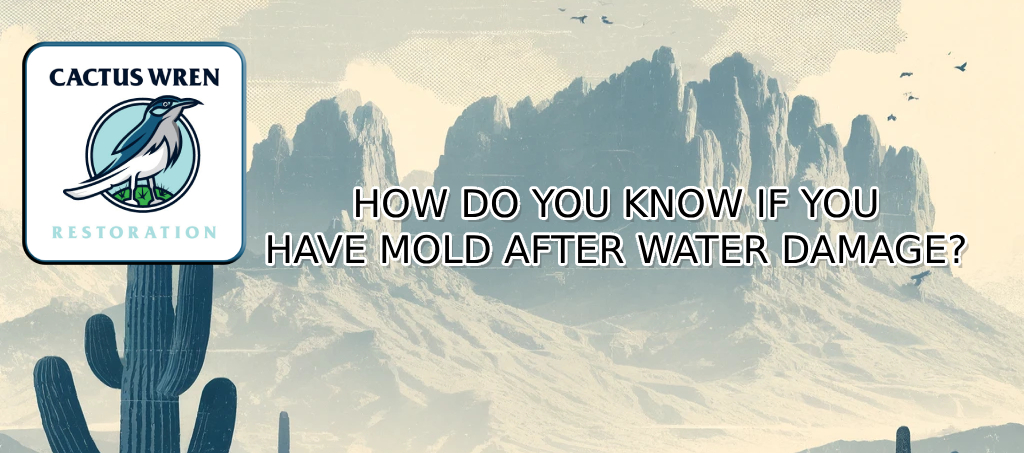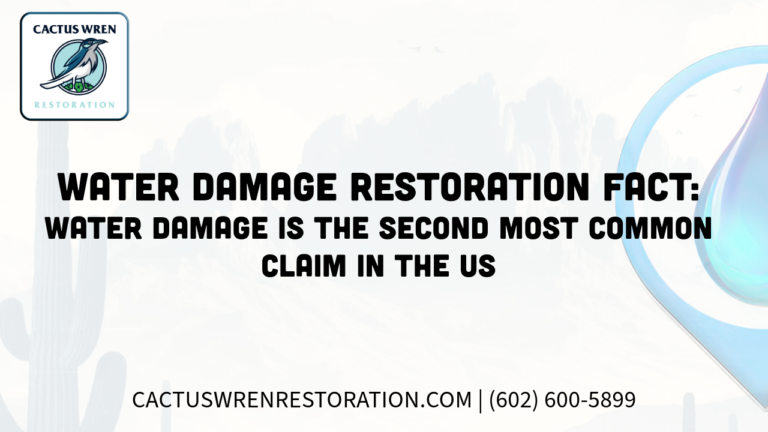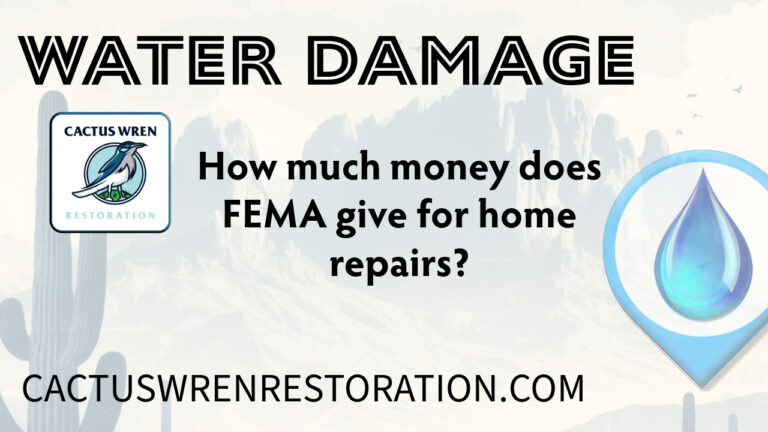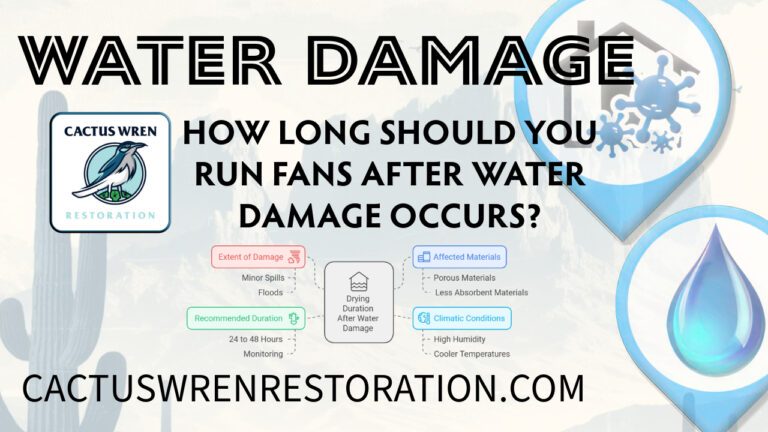Table of Contents
ToggleIntroduction
Imagine, for a moment, your home as a canvas, untouched and flawless. Then, unexpectedly, water damage storms in like an uninvited artist, streaking the canvas with unwelcome hues. The aftermath? A potential breeding ground for an invisible intruder—mold. It’s a scenario many homeowners dread, yet many face. The question that then arises, as ominous as a cloud-laden sky, is: How do you know if you have mold after water damage?
Understanding the signs of mold growth and the steps to address it becomes as crucial as a captain knowing how to navigate stormy seas. This guide, akin to a lighthouse, aims to illuminate the path through the murky waters of post-water damage mold identification, remediation, and prevention. Whether you’re a seasoned homeowner or a novice, knowing the signs of mold and how to combat its growth is paramount in maintaining the sanctity and safety of your living space. Let’s embark on this journey, armed with knowledge and readiness, to confront and conquer the challenges posed by mold after water damage.
If you’re dealing with the aftermath of water damage in Mesa, Arizona, or simply looking to arm yourself with information, you’re in the right place. Together, we’ll explore the telltale signs of mold, understand its implications, and learn how to forge a path towards restoration and peace of mind.
What is mold and why is it a concern after water damage?
Mold, the uninvited guest that thrives in the aftermath of water damage, is more than just an unsightly blight on your home’s canvas. It’s a living organism, a master of stealth and survival, that sinks its roots into damp environments and prospers in the shadows. But why does it command our attention and concern? Imagine mold as nature’s reclaiming agent, a reminder that our homes are not just our sanctuaries but part of a larger, living world. However, when mold invades our living spaces, it becomes a foe rather than a friend.
Mold’s concerns aren’t just aesthetic. They’re deeply rooted in health implications. Breathing in the spores of mold is akin to inviting a Trojan horse into your body, potentially unleashing a myriad of respiratory issues, allergic reactions, and in severe cases, neurological problems. It’s as if the air within your own fortress turns against you, silently chipping away at your health.
Moreover, mold’s presence signals underlying water issues that, if left unchecked, could erode the very foundations of your home. Like a castle besieged, walls and structures can weaken over time under the relentless assault of moisture and mold. Thus, recognizing mold’s implications is the first step in fortifying your home against its silent encroachment.
Understanding the enemy is paramount in any battle, and in the context of our homes, knowledge is our strongest weapon. Let us delve deeper into identifying the telltale signs of mold, offering you the insight needed to detect and address this unwelcome intruder promptly. Armed with this knowledge, you stand ready to protect your sanctuary, ensuring it remains a haven, not just for you but for generations to come.
For those navigating the aftermath of water damage, whether in Mesa, Arizona or beyond, recognizing mold’s significance is a crucial step in the journey towards recovery and peace of mind. With awareness and action, we can reclaim our homes from the grasp of mold and restore the canvas of our lives to its pristine state.
Signs of mold growth after water damage
Embarking into the heart of our home’s post-storm saga, we find ourselves in search of a phantom—mold. This elusive adversary doesn’t always march openly; rather, it prefers the art of stealth, making its presence known through subtler, yet unmistakable signs. Identifying these signs is akin to deciphering the whispers of our home, urging us to take action before the intruder solidifies its foothold.
Imagine walking into a room and being greeted by a musty odor, as if the walls themselves are recounting tales of forgotten, damp basements. This scent is often the first herald of mold’s presence, a clear signal that it’s time to sharpen our senses and look closer. But what do we seek? Visual confirmation comes in the form of colorful blotches—green, black, or even white—splattered across walls, ceilings, or hidden in corners like a mischievous sprite. These marks are not mere blemishes on the surface; they are mold’s flag, claiming territory within our sanctum.
Yet, the signs do not stop at what we can see and smell. Mold, in its insidious spread, can provoke our bodies to react. Allergic reactions—sneezes, coughs, or itchy eyes—may become more frequent, as if our bodies are raising alarms against an unseen foe. And let’s not overlook the more subtle indicators, such as water stains or discoloration on surfaces, whispering tales of water’s past incursions and mold’s ensuing conquest.
Discovering these signs within our homes can evoke a sense of urgency, a call to arms to address the invisible enemy before its roots dig deeper. But fear not, for knowledge is our sword and vigilance our shield. By understanding and recognizing these signs, we empower ourselves to act swiftly, to cut through the shadows with the light of awareness and reclaim the sanctity of our homes.
For those who have witnessed the signs of mold in their abode, especially following water damage, the journey might seem daunting. Yet, it is a path tread by many before, leading not to despair but to restoration and peace. If you find yourself facing such challenges in Mesa, Arizona, know that you’re not alone. Resources and professionals are ready to guide you through this storm, ensuring that your canvas—your home—remains a masterpiece of resilience and health.
Visible mold growth
Imagine your home as a fortress, stoic and steadfast. Yet, within its walls lurks an invader, not wielding swords or arrows, but spores—mold. This adversary doesn’t announce its arrival with a clamor but prefers a silent conquest, manifesting as visible mold growth. It’s as if the walls themselves bear the scars of an unseen battle, with patches of green, black, or white serving as the banners of an occupying force.
Spotting visible mold growth is akin to finding the hidden tracks of an intruder within your domain. It’s a clear, unequivocal sign that mold has breached your defenses and taken residence. These visual cues can range from small, insidious patches lurking in damp corners to vast colonies that spread like wildfire across walls and ceilings. Each mark is a testament to mold’s relentless quest for dominance within your sanctuary.
But why should this concern us? Beyond the immediate assault on aesthetics, visible mold growth is the harbinger of deeper issues. It speaks of moisture’s triumph over the bulwarks of our homes, of water damage left unchecked, allowing mold to flourish. This growth is not merely a blemish to be wiped away; it is a signal flare, urging us to delve deeper and root out the source of the moisture that feeds it.
Addressing visible mold growth is not just about reclaiming the beauty of our homes; it’s about fortifying our fortresses against further incursion. It’s about ensuring the air within our walls is pure, not a poison. By recognizing and acting upon the sight of mold, we engage in a battle not just for the integrity of our homes but for the health and wellbeing of all who dwell within.
In the campaign against mold, especially in the wake of water damage, every homeowner must become a vigilant guardian. If your stronghold lies within Mesa, Arizona, or elsewhere, the battle may seem daunting. Yet, with the right knowledge and resources, victory is within reach. Let us not view visible mold growth as a sign of defeat but as a call to arms, a challenge to rise and restore our homes to their former glory.
Musty odors
Like a ghostly whisper in the night, musty odors can seep into the fabric of our homes, elusive yet unmistakable. This scent, often reminiscent of damp, forgotten spaces, is not merely an olfactory nuisance; it serves as a clarion call, alerting us to the presence of an unseen adversary—mold. Just as a seasoned sailor can read the winds and predict a storm, so too can we learn to interpret these musty signals as heralds of mold’s silent siege upon our sanctuaries.
Imagine, if you will, entering a room and being enveloped by an air of neglect, as though the room itself is exhaling the breath of a bygone era. This is no mere trick of the imagination but a tangible sign of mold’s clandestine campaign within our walls. The odor is mold’s invisible flag, staked in the hidden recesses of our homes, signaling its claim over our once pristine environments.
Why should this scent raise our alarms? For the same reason a captain heeds the gathering clouds on the horizon. Musty odors are not just indicators of mold’s presence; they are harbingers of its potential to infiltrate our lives, compromising not only the structural integrity of our homes but the very air we breathe. It’s a sign that our homes, our fortresses, are under assault from within, with moisture as the invader’s ally.
Confronting musty odors is not simply a matter of airing out a room or lighting a candle. It’s a call to action, a summons to hunt down the source of the odor and, by extension, the mold it signifies. Addressing this issue head-on is akin to patching a breach in our defenses, ensuring that our homes remain sanctuaries of health and comfort, not bastions of decay and disease.
For those who have detected this telltale scent, especially after experiencing water damage, the journey ahead may seem daunting. Yet, it is a path that leads not to despair but to resolution and rejuvenation. If you’re navigating these challenges in Mesa, Arizona, take heart; resources and experts stand ready to assist you in this quest. Together, we can trace the scent to its source, eradicate the mold, and restore the fresh, clean air that should grace our homes.
Allergic reactions
Like a knight unwittingly wearing armor laced with thorns, we might find ourselves besieged by allergic reactions within the very walls meant to protect us. These reactions, ranging from the subtle whisper of a sneeze to the tumultuous storm of respiratory distress, are not mere inconveniences. They are the body’s clarion call, its way of signaling an invisible but relentless foe: mold. Just as a beast leaves tracks, so too does mold leave its mark upon our health, unveiling its presence through our body’s protests.
Imagine, then, the air in your sanctuary—meant to be a source of life—becoming a carrier of unseen adversaries. Each breath, a potential invitation to unseen spores seeking harbor within you. This isn’t the plot of a fantastical tale but a stark reality for those grappling with mold’s insidious spread. Allergic reactions serve as the body’s defense mechanism, a lighthouse beacon warning of danger lurking in the unseen.
Why should we heed these bodily alarms? Because behind every sneeze, cough, or itch lies a tale of an environment out of balance. Mold’s presence disrupts not just the physical structure of our homes but invades the very air we consider our lifeblood. Allergic reactions are the frontline of our body’s defense, urging us to unearth and eradicate the source of our malaise.
Addressing these allergic reactions requires more than just antihistamines or temporary relief. It calls for a crusade against the root cause—moisture and mold. Like turning the tide in a siege, identifying and remedying mold infestations can restore harmony to our living spaces and health to our bodies. This battle isn’t fought with swords but with vigilance, knowledge, and the resolve to reclaim our health and homes from mold’s grip.
For those embroiled in this struggle, particularly after facing water damage, remember: you are not alone. Whether you’re in Mesa, Arizona, or beyond, resources and allies stand ready to join your fight. Together, we can trace the symptoms back to their source, banishing mold and restoring the sanctity of our air. This journey, though daunting, leads not to a battleground but towards a restoration of peace and well-being within our cherished sanctuaries.
Water stains or discoloration
Imagine your home as a tapestry, each corner and crevice woven with memories and moments. Yet, upon closer inspection, you might notice irregular patches resembling watercolors gone awry—water stains or discoloration. These are not merely blemishes on the fabric of your home; they are silent storytellers, narrating tales of unseen battles between moisture and material. Recognizing these signs is akin to deciphering ancient runes, offering insights into the presence of an invisible adversary: mold.
Water stains or discoloration often appear as vague whispers on walls, ceilings, or floors—subtle hints of a disturbance in the equilibrium of your home. Like a shadow creeping slowly across a room, these marks gradually reveal themselves, a testament to water’s insidious infiltration. They serve as a map, guiding us to the heart of moisture’s domain, where mold lies in wait, ready to claim new territories within our sanctuaries.
But why should these seemingly innocuous signs alarm us? Imagine these stains as scars left by an intruder; they are evidence of water’s passage, a trail left behind that leads to mold’s lurking presence. Addressing these water stains and discolorations is not merely a cosmetic affair; it is an act of reclaiming your home’s integrity, a preventative strike against mold’s silent siege.
Confronting these signs requires more than a fresh coat of paint or a simple cover-up. It demands a journey to the source, a quest to rectify the conditions that allowed moisture to breach our defenses. This endeavor is not for the faint of heart; it is a declaration of war against the elements themselves, a commitment to fortify our homes against future invasions.
For those who have discovered such signs, especially in the wake of water damage, the path ahead may seem daunting. Yet, it is a journey worth undertaking, for the sake of our homes and our health. If you’re navigating this challenge in Mesa, Arizona, remember, you are not alone. Resources, expertise, and support are within reach, ready to assist you in this noble endeavor. Together, we can trace the origins of these water stains, eradicate mold at its source, and weave a new chapter in the tapestry of our homes, one free of discoloration and full of promise.
Steps to take if you suspect mold after water damage
Embarking on a journey through a forest, you might encounter signs that guide you, whether it’s a path marked by stones or the distant sound of a river guiding you to water. Similarly, in the labyrinth of your home, if you stumble upon signs of mold after water damage, it’s crucial to have a compass of actions to guide you through. How do you navigate this forest of uncertainty? How do you reclaim the sanctity of your home? The steps are your stones, marking the path to restoration and peace.
Firstly, imagine yourself as a detective stepping into a scene where every clue matters. Documenting the water damage is akin to gathering evidence, a crucial step that not only aids in understanding the extent of the damage but also serves as pivotal information for insurance claims and remediation efforts. Just as a map charts out a journey, documentation illuminates the path forward.
Following the trail of clues, the next step beckons—a call to those with specialized skills. Contacting a professional mold inspector is like enlisting a guide, someone who knows the terrain and can lead you safely through. These experts, with their tools and knowledge, can unearth the hidden alcoves where mold lurks, offering clarity and direction in the otherwise murky waters of uncertainty.
As you progress, creating a barrier between the affected area and the rest of your sanctuary is akin to setting up camp in the safe zones of a forest, away from the dangers that lurk in the shadows. Isolating the affected area prevents the spread of mold spores, akin to containing a wildfire before it engulfs the forest. This step is a protective charm, safeguarding the health of your home’s inhabitants.
The final stride in your journey is the mold remediation process—a path that leads from the dark woods back into the light. This process is not just about eradicating the visible signs of mold but addressing the root cause, much like healing the land to prevent future forests from withering. It’s a commitment to restore, to breathe life back into every corner and crevice of your home.
For those navigating this path in Mesa, Arizona, or anywhere else, remember that this journey, though daunting, is not one you walk alone. Resources, professionals, and a wealth of knowledge stand ready to guide you through. With each step taken, you’re not just moving towards a home free of mold but reclaiming the narrative of your sanctuary, ensuring it remains a place of health, happiness, and peace.
Document the water damage
Imagine yourself as a navigator of the high seas, where every gust of wind and shift in the tides is meticulously recorded in your logbook. This is not so different from the first crucial step you must take in the aftermath of water damage: documenting every detail. Like a cartographer mapping uncharted territories, you are tasked with capturing the extent of the damage, a vital endeavor that serves as both a beacon for future remediation efforts and a shield in dealings with insurance claims.
Why, you might ask, is this step so critical? Picture this: your home, a vessel that has weathered a storm, its sails torn and deck awash. Without a detailed log of the damage, how can you prove the storm ever happened? How can you argue for the resources needed to repair and restore? Documentation is your tangible proof, your ledger of losses and needs. It’s as if you’re gathering evidence for a trial, where the verdict depends on the clarity and thoroughness of your presentation.
But how do you embark on this task? Begin with photographs—lots of them. Like an artist capturing every nuance of a scene, your photos should detail the damage from every angle. Follow this with notes, as detailed as the logs of a ship’s captain, noting the date, the extent of the damage, and any immediate steps taken to mitigate further losses. This record will be your guide through the tumultuous waters of insurance claims and remediation strategies, a lighthouse guiding you back to safety.
Remember, the journey of restoring your home, much like charting a course through unknown waters, begins with a single, well-documented step. For those facing the aftermath of water damage, perhaps in places like Mesa, Arizona, this step is not just about recording loss but about setting the stage for recovery and rebirth. With each detail noted, you’re not merely documenting damage; you’re laying the foundation for your home’s return to its former glory.
Contact a professional mold inspector
In the aftermath of water damage, taking the step to contact a professional mold inspector is akin to summoning a seasoned navigator when you find yourself adrift in uncharted waters. This action is not merely a call for help; it’s an acknowledgment of the complexity and dangers of mold, an invisible adversary that can lurk in the most unexpected nooks of your home. Just as a skilled sailor can read the stars to guide a ship to safe harbor, a professional mold inspector uses expertise and specialized tools to unveil the presence and extent of mold invasion in your sanctuary.
Why, you might ponder, is this step so crucial? Imagine, if you will, embarking on a journey through a dense forest without a guide. The path is fraught with unseen perils and misleading trails. Similarly, attempting to tackle mold on your own can be a perilous endeavor. Mold is a cunning foe, hiding behind walls, under floors, and in the air itself. Without the keen eye of a professional, one might only scratch the surface of the problem, allowing the mold to regroup and mount a fresh assault on your home.
Engaging a professional mold inspector is like lighting a torch in the darkest of dungeons. They illuminate the hidden corners, charting a map of the mold’s stronghold within your domain. Through thorough inspection and testing, they provide you with a clear picture of the battlefield, empowering you with the knowledge to plan an effective counterattack.
For those who have witnessed the silent signs of mold in the wake of water damage, especially in regions susceptible to this plight, such as Mesa, Arizona, taking this step is not just advisable; it’s imperative. A professional mold inspector is not just a guide; they are your ally in the fight against mold. With their expertise, you can navigate the murky waters of mold remediation with confidence, ensuring that your home returns to being a safe haven, free from the clutches of this silent but formidable foe.
Isolate the affected area
Embarking on the quest to isolate the affected area after detecting mold is akin to drawing a line in the sand against an encroaching tide. It’s not just a defensive maneuver; it’s a strategic step, one that ensures the safety of your domain while preparing for a counteroffensive. Imagine, if you will, your home as a kingdom, and within its walls, a breach has occurred. Isolating the affected area is like closing the gates, preventing the invader—mold—from spreading its influence further into your realm.
Why is this isolation so crucial, you might ask? Picture mold as an insidious whisper, spreading its tales of decay through the air, invisible and fast. Without erecting barriers, this whisper can become a shout, reaching into every corner of your home, sowing seeds of destruction. By isolating the affected area, you’re muffling this voice, containing its spread, and protecting the untouched parts of your kingdom. It’s a battle of containment, ensuring the enemy is cornered and more manageable to defeat.
How does one effectively isolate this unseen foe? It starts with the physical—sealing off the area with plastic sheeting and tape, a modern-day portcullis. This barrier becomes your fortress wall, beyond which the mold cannot pass. Ventilation systems are shut off or sealed to prevent the spread of spores, akin to cutting off the enemy’s supply lines. The goal is to create a contained battlefield, where the fight against mold can be waged without risking the rest of your home.
For those standing on the threshold of this battle, especially in areas prone to water damage like Mesa, Arizona, isolating the affected area is a crucial step. It’s not just about containment; it’s about preparing the ground for remediation, ensuring that when you strike against the mold, it’s a decisive blow. This step, while seemingly simple, is a powerful tactic in the broader strategy of reclaiming your home from mold’s grasp, turning it once again into a sanctuary of health and peace.
Begin the mold remediation process
Embarking on the mold remediation process is akin to setting sail into the storm, armed with knowledge and the will to reclaim what has been lost. It’s not merely about cleaning up; it’s a deeply strategic endeavor, a battle to restore the sanctity of your home. Imagine, if you will, your abode as a besieged castle. The gates have been breached, and now it’s time to drive the invaders out, to cleanse the halls and restore order. This is the essence of mold remediation: a concerted effort to eradicate the mold, to heal the wounds inflicted upon your dwelling.
Why, you might wonder, is this process so vital? Consider mold as a relentless adversary, lurking in the shadows, ready to spread chaos at every opportunity. Left unchecked, it can undermine the very foundations of your home, both literally and metaphorically. The remediation process is your counterattack, a way to cut the enemy off at the knees, to ensure that every spore is vanquished, and the conditions that allowed it to thrive are corrected. It’s not just about cleaning; it’s about reclaiming your domain from an unseen foe.
The process itself is both an art and a science. It begins with containment, to prevent the spread of mold spores during the clean-up. This is followed by the actual removal of mold-infested materials, a delicate operation that requires precision and care. Affected areas are then cleaned and disinfected, eradicating the mold’s presence. But the battle doesn’t end there. The final, crucial step is repair and restoration, fixing the damage and addressing the moisture issues that gave rise to the mold in the first place. It’s a holistic approach, ensuring not just the eradication of the mold but the health and integrity of your home.
For those who are at the threshold of this daunting journey, especially residents of Mesa, Arizona, where the climate can exacerbate mold issues, know that this process, though challenging, is the path to redemption. It’s a journey back to safety, to a home that once again serves as a sanctuary, free from the clutches of mold. With each step of the remediation process, you’re not just removing mold; you’re weaving resilience and health back into the fabric of your abode, ensuring it stands strong against future invasions.
Preventing mold growth after water damage
As we emerge from the tumultuous journey of mold remediation, our thoughts turn to the future—to ensuring that our homes, our sanctuaries, remain steadfast against the insidious creep of mold. Imagine, if you will, standing on the battlements of a fortress, having repelled an invading force. The air is crisp, the sky clear, but the memory of battle lingers. It’s in this moment of calm that we must fortify our defenses, lay down strategies, and enact measures to prevent mold’s unwelcome return. This is not just about safeguarding our homes; it’s about preserving our health and well-being.
Why is prevention so critical? Think of mold as a cunning adversary, always searching for a breach in our defenses, a lapse in vigilance. Water damage, with its inherent moisture and dampness, provides the perfect beachhead for mold to establish a foothold. By taking proactive steps to prevent mold growth, we’re not just repairing the aftermath of a storm; we’re altering the very environment that invites mold in, turning our homes into fortresses impervious to its advances.
How do we embark on this mission of prevention? It begins with addressing the source of water damage—be it a leaky roof, a burst pipe, or floodwaters. This is akin to sealing the gates of our fortress, ensuring no adversary can slip through. Properly drying and ventilating the affected area follows, like airing out the dark, damp corridors of a castle, denying mold the shadows it craves. Employing mold-resistant materials during repairs or renovations acts as upgrading our walls and towers, making them more resilient to future sieges. Finally, maintaining proper humidity levels within our homes is like keeping a vigilant watch over the horizon, ready to spot and address any threat before it can approach.
For those who have navigated the stormy seas of water damage and mold remediation, especially in locales prone to such challenges like Mesa, Arizona, the journey towards prevention is a crucial next step. It’s a commitment to vigilance, to continuous improvement, and to the health and integrity of our homes. Let us embrace these preventative measures not as burdens, but as the keystones of a safe, healthy, and mold-free living environment. Armed with knowledge and a proactive stance, we can ensure that our homes remain our sanctuaries, inviolable and steadfast against the creeping shadows of mold.
Addressing the source of water damage
Embarking on the critical task of addressing the source of water damage is akin to tracking down the elusive beast that threatens the tranquility of your kingdom. It’s a quest not for the faint of heart, for it requires diligence, insight, and a steadfast resolve. Imagine, if you will, your home as a realm under siege, not by armies clashing at the gates, but by an invisible force that seeps through the very foundations, eroding the sanctuary you’ve built. This force, water damage, is a cunning adversary, capable of striking unseen, leaving behind a trail of decay for mold to flourish.
Why, then, is identifying and rectifying the source of water damage so imperative? Consider this: without knowing the origin of the flood, how can you hope to stem the tide? It’s as though you’re standing atop your castle walls, watching the waters rise, yet unable to locate the breach. Water damage, left unchecked, not only paves the way for mold’s insidious spread but also undermines the structural integrity of your home. It’s a silent whisper that grows into a roar, threatening the very fabric of your abode.
To embark on this noble quest, one must first arm themselves with knowledge and vigilance. The journey begins with a thorough inspection, a detailed survey of your domain to uncover the hidden springs of this unwanted deluge. Be it a leaky roof, akin to a broken shield, or a burst pipe, a treacherous undercurrent within your walls, each potential source must be identified with precision. This step is not merely about patching a leak; it’s about fortifying your fortress against the relentless assault of the elements.
Addressing the source of water damage is akin to repairing the breach in your castle’s defenses. It’s a foundational step, one that ensures the safety and sanctity of your home. For those who have faced the aftermath of water damage, especially in areas prone to such challenges like Mesa, Arizona, this endeavor is not just about restoration. It’s a commitment to resilience, to ensuring that your home stands as a bulwark against the forces of nature, impervious to the whispers of decay and the shadows of mold. In this quest, you’re not just a homeowner; you’re a guardian of your realm, a defender of your sanctuary.
Properly drying and ventilating the affected area
Stepping into the aftermath of water damage can feel like walking through the ruins of a forgotten city, where the air is thick with the scent of dampness and decay. It’s a world temporarily out of balance, a realm where shadows linger longer, and the air whispers with the chill of moisture. In this moment, the task before you—to properly dry and ventilate the affected area—is akin to being a beacon of light, a restorer of order in the midst of chaos. This step is not merely about moving air or expelling water; it’s about reclaiming the sanctity of your space from the clutches of potential mold infestation.
But why, you might ask, is this process so crucial? Imagine, if you will, mold as an opportunistic invader, awaiting the slightest lapse in vigilance to establish its dark empire. Moisture is its ally, the very lifeblood that fuels its silent conquest. By thoroughly drying and ventilating the affected areas, you’re cutting off this lifeline, starving the invader before it can even begin its assault. It’s as if you’re clearing the fog from a battlefield, ensuring clarity and strength in your defenses.
Effective drying and ventilation require more than just opening windows or running a fan; it’s a concerted effort that demands strategy and precision. Dehumidifiers stand as sentinels, pulling moisture from the air, while air movers act as the cavalry, circulating fresh air and hastening the drying process. This dual approach is like a well-orchestrated symphony, each element playing its part to restore harmony and balance to your home. The goal is to create an environment where mold cannot thrive, an atmosphere that is inhospitable to the agents of decay.
For those who find themselves in the throes of this battle, especially in regions where humidity is a constant companion, like Mesa, Arizona, the importance of drying and ventilating cannot be overstated. It’s a pivotal step in the journey toward recovery, a foundation upon which the future health of your home is built. As you embark on this crucial task, remember, you are not merely moving air or expelling moisture; you’re weaving a tapestry of resilience, crafting an environment where health and wellbeing can flourish, free from the shadowy grip of mold.
Using mold-resistant materials during repairs or renovations
Embarking on the journey of repairs or renovations after water damage is akin to the rebirth of a phoenix from ashes—a chance to not only restore but to reimagine and reinforce. In this transformative process, using mold-resistant materials becomes the cornerstone of building a sanctuary that stands resilient against the silent invader, mold. This step is not just about healing the wounds left by water; it’s about armoring your home with an invisible shield, ensuring that it emerges stronger, more impervious to the threats that once brought it to its knees.
But why, you might ponder, is the choice of materials so critical in this battle against mold? Imagine, if you will, a fortress whose walls are impervious to the siege engines of an enemy. Mold-resistant materials are the stone and mortar of such fortifications in the realm of your home. They are the unsung heroes that repel the advance of moisture and deny mold the foothold it seeks. By integrating these materials into your renovations, you’re inscribing runes of protection into the very fabric of your dwelling, creating barriers that mold cannot cross.
The alchemy of incorporating mold-resistant materials into your repairs involves more than just selecting the right products; it’s an art form that weaves together innovation and tradition. From moisture-resistant drywall that stands as a bulwark against dampness to paints imbued with antimicrobial properties that ward off mold’s advance, each choice is a strategic move in the grand chess game of home restoration. These materials act as the guardians of your realm, silent sentinels that protect against the encroachment of decay.
For those standing at the threshold of rebuilding in the wake of water damage, especially in regions where the climate is an ally to mold, like Mesa, Arizona, the selection of mold-resistant materials is not merely a recommendation; it’s an imperative. It’s a commitment to not just repair, but to renew and reinforce, ensuring that your home stands as a testament to resilience, a sanctuary that defies the elements and safeguards the health and happiness of those who dwell within.
As you navigate the path of restoration, remember that the choices you make today are the foundation stones of tomorrow’s sanctuary. In the embrace of mold-resistant materials, your home becomes more than just a structure; it becomes a fortress against the unseen, a stronghold of health and wellbeing, resilient in the face of adversity.
Maintaining proper humidity levels
Imagine your home as a living, breathing entity, its every nook and cranny pulsating with life. Yet, within this vibrant ecosystem, an invisible balance is at play—a delicate dance between air and moisture. Maintaining proper humidity levels is akin to conducting this symphony, ensuring each note resonates in harmony, preventing the discordant melody of mold from ever taking root. This task, seemingly mundane, is a powerful spell cast to protect your sanctuary from the insidious creep of decay.
But why, you might wonder, does this balance hold such power? Envision, if you will, moisture as a siren’s call, luring the unseen spores of mold to settle and multiply. Proper humidity levels act as a barrier, silencing this call, rendering the air inhospitable to those seeking to invade. It’s a battle waged not with visible weapons but with the invisible forces of air and water, a battle where victory means a home preserved, a haven safeguarded.
To wield this power effectively requires more than just intuition; it demands vigilance and technology. Hygrometers become your scouts, alerting you to shifts in the humidity landscape. Dehumidifiers serve as your warriors, standing guard to remove excess moisture from the air. Together, they form a dynamic defense system, a bulwark against the conditions that mold thrives upon. By maintaining humidity levels within the recommended range—ideally between 30% and 50%—you ensure your home remains a fortress, resilient against the silent threat of mold.
For those who have faced the tempest of water damage, particularly in climates where the air teems with moisture, like the verdant expanses of Mesa, Arizona, the imperative of controlling humidity cannot be overstated. It’s not merely a step towards recovery; it’s a leap towards prevention, a fundamental aspect of creating a healthy, mold-resistant living space. In this effort, you’re not just adjusting the air; you’re sculpting an environment where well-being flourishes, where the air itself becomes a guardian of your sanctuary.
As you navigate this journey, remember that maintaining proper humidity levels is more than a technical task—it’s an act of stewardship, a commitment to the health of your home and those who dwell within. By mastering this delicate balance, you transform your living space into a bastion of health, a bulwark against the unseen forces of decay. In the grand narrative of your home, let this chapter be one of resilience, a testament to your vigilance and care in the face of adversity.
Key Takeaways
As we draw the curtains on this enlightening journey through the shadowy realms of mold and water damage, let us pause and reflect on the pearls of wisdom we’ve gathered along the way. Like intrepid explorers returning from uncharted territories, we bring back not just tales of challenges faced but invaluable treasures in the form of knowledge and strategies to fortify our homes against the silent adversary that is mold.
First and foremost, we’ve learned that mold is not merely an inconvenience but a formidable foe, capable of stealthily undermining the sanctity of our homes and the health of our loved ones. It thrives in the aftermath of water damage, a reminder that vigilance and prompt action are our best defenses in the battle against this unseen invader.
We’ve also discovered that recognizing the signs of mold—be it the musty odors that whisper of hidden decay, the unsightly patches of discoloration that mar our walls, or the subtle yet telling symptoms of allergic reactions—is akin to reading the language of our homes, a crucial step in mounting an effective defense.
In our quest to reclaim our sanctuaries from the clutches of mold, we’ve navigated the steps necessary to address and remediate mold growth, from the meticulous documentation of water damage to the strategic isolation of affected areas and the thorough eradication and repair processes that follow. Each step is a critical move in the grand chess game of home restoration, where foresight and precision ensure victory.
But perhaps the most enduring lesson lies in the art of prevention. We’ve learned that by addressing the sources of water damage, properly drying and ventilating our spaces, using mold-resistant materials, and maintaining optimal humidity levels, we can create fortresses—homes that stand resilient against the encroachment of mold. This is not just about repair; it’s about transformation, about weaving resilience and health into the very fabric of our living spaces.
For those who’ve walked this path, especially in areas prone to the challenges of water damage such as Mesa, Arizona, these key takeaways are not merely guidelines but beacons of hope. They are a testament to our ability to rise, phoenix-like, from the ashes of adversity, armed with the knowledge and strategies to ensure our homes remain sanctuaries of health, happiness, and peace.
Let us carry forward these lessons, not as burdens, but as the tools and treasures that they are, ensuring that our homes—our castles—stand steadfast against the silent shadows of mold, now and for generations to come.
Conclusion
As we stand on the shores of understanding, looking back at the vast ocean of knowledge we have navigated, it’s clear that the journey through the realms of mold and water damage is one marked by vigilance, resilience, and an unwavering commitment to the sanctity of our homes. The specter of mold, born from the aftermath of water damage, has been revealed not as an invincible foe, but as one that can be confronted and vanquished with the right tools, knowledge, and determination.
In this odyssey, we’ve unearthed the signs that whisper of mold’s presence, unmasked the strategies to combat its spread, and charted the course towards prevention, turning our homes into fortresses against future incursions. Each lesson learned is a beacon, guiding us through the fog of uncertainty, illuminating the path to a home that stands not only as a shelter but as a bastion of health and well-being.
The journey does not end here, however. Like the ever-shifting sands of a desert, the landscape of our homes is in constant flux, influenced by the elements, time, and human activity. Vigilance must be our constant companion, awareness our guide. The battle against mold and water damage is ongoing, but armed with the insights gleaned, we stand ready to face whatever challenges may come, ensuring our homes remain sanctuaries of comfort, safety, and joy.
For those who have walked this path in Mesa, Arizona, or anywhere else, know that the journey towards a mold-free home is not a solitary one. Resources, professionals, and a community of fellow navigators stand ready to support you, offering their knowledge and expertise to guide you towards a future where the air within your walls is as pure as the intentions behind their construction.
Let this guide serve not only as a map through the treacherous waters of mold remediation and prevention but as a testament to the resilience of the human spirit, to our unyielding desire to create and sustain environments where life can thrive. As we close this chapter, let us move forward with confidence, knowing that we are equipped to preserve the sanctity of our homes against the silent threats that lurk within and without, ensuring they stand as havens of health and happiness for all who dwell within their walls.







